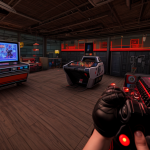Are you tired of your favorite games demanding more and more from your system? You’re not alone. In recent years, fast-paced games have become increasingly demanding, requiring higher and higher levels of hardware to run smoothly. But why is this happening? And what does it mean for gamers like you and me? In this article, we’ll explore the reasons behind the rising demands of fast-paced games and what you can do to keep up with the latest releases. So, buckle up and get ready to dive into the world of high-performance gaming!
Fast-paced games are becoming more demanding as technology advances and gamers expect more realistic and immersive experiences. With the increasing power of gaming hardware, game developers are able to create more complex and detailed worlds, with higher resolutions, smoother animations, and more realistic physics. Additionally, as online gaming becomes more popular, players are seeking fast-paced games that offer intense competition and challenging gameplay. Fast-paced games also require more processing power to run smoothly, which means that players need to have powerful hardware to enjoy them. Overall, the demand for fast-paced games is driven by the desire for more immersive and realistic gaming experiences, as well as the need for hardware that can keep up with the demands of modern games.
The Evolution of Fast-Paced Games
Advancements in Technology
The gaming industry has seen a significant transformation due to technological advancements. With the development of new hardware and software, game developers have been able to create more complex and engaging games. Here are some ways in which technology has impacted fast-paced games:
- Increased processing power: The improvement in the processing power of computers and gaming consoles has allowed for more detailed graphics and smoother gameplay. This has enabled game developers to create more visually stunning and immersive environments for players to enjoy.
- Advanced physics engines: The integration of advanced physics engines in games has enabled realistic simulations of physical interactions. This has made fast-paced games more challenging and engaging, as players must now contend with realistic environmental factors that affect gameplay.
- Wireless connectivity: The advent of wireless connectivity has enabled players to connect with each other from anywhere in the world. This has led to the growth of online gaming and the development of more complex multiplayer modes in fast-paced games.
- Cloud gaming: Cloud gaming technology has enabled players to access games on a variety of devices without the need for expensive hardware. This has made fast-paced games more accessible to a wider audience and has contributed to the growth of the gaming industry.
Overall, the advancements in technology have played a significant role in the evolution of fast-paced games. As technology continues to evolve, it is likely that fast-paced games will become even more demanding and engaging for players.
Player Expectations and Demands
As the gaming industry continues to evolve, so too do the expectations and demands of players. Fast-paced games, in particular, have seen a significant shift in what players expect from their gaming experience. This shift can be attributed to a number of factors, including the increasing sophistication of players, the growing popularity of eSports, and the rise of mobile gaming.
Increasing Sophistication of Players
One of the primary reasons for the growing demands of players is the increasing sophistication of gamers themselves. As more people become familiar with the intricacies of gaming, they develop higher expectations for the level of challenge and complexity they expect from their games. This has led to a greater emphasis on realism, immersion, and customization in fast-paced games.
Growing Popularity of eSports
Another factor driving the demands of players is the growing popularity of eSports. Competitive gaming has exploded in recent years, with major tournaments and events attracting millions of viewers worldwide. As a result, players are increasingly looking for fast-paced games that offer a high level of competition and skill-based gameplay. This has led to a greater emphasis on online multiplayer modes and leaderboards, as well as more complex game mechanics and strategies.
Rise of Mobile Gaming
Finally, the rise of mobile gaming has also played a significant role in shaping player expectations and demands. With the proliferation of smartphones and tablets, mobile gaming has become a major force in the industry. Fast-paced games on mobile devices need to be designed with shorter attention spans and quicker play sessions in mind, but they still need to offer the same level of excitement and challenge as their console and PC counterparts. This has led to a greater emphasis on accessibility, ease of use, and addictive gameplay mechanics.
Overall, the evolution of fast-paced games is being driven by the changing expectations and demands of players. As the industry continues to grow and evolve, it will be interesting to see how game developers respond to these challenges and continue to push the boundaries of what is possible in fast-paced gaming.
The Impact of Competitive Gaming
As competitive gaming has gained popularity, the demand for fast-paced games has increased. These games require players to be quick on their feet, have sharp reflexes, and the ability to think on their feet. Competitive gaming has also led to the development of new genres of games, such as esports, which are designed specifically for competitive play.
One of the main reasons for the popularity of competitive gaming is the social aspect of the sport. Players can join teams, compete against other players online, and even attend live events to watch their favorite teams and players compete. This social aspect of the sport has led to the development of online communities and forums where players can discuss strategies, share tips, and connect with other players.
Another reason for the popularity of competitive gaming is the level of skill and strategy required to succeed. These games require players to have a deep understanding of the game mechanics, as well as the ability to think quickly and adapt to changing situations. This level of skill and strategy has led to the development of professional leagues and tournaments, where players can compete for large sums of money and prestige.
The impact of competitive gaming has also led to the development of new technologies and tools to help players improve their skills. For example, players can use software to track their performance, analyze their gameplay, and identify areas for improvement. They can also use specialized gaming peripherals, such as gaming mice and keyboards, to gain an edge over their opponents.
Overall, the impact of competitive gaming has had a significant impact on the development of fast-paced games. As the popularity of these games continues to grow, we can expect to see even more innovation and evolution in the world of competitive gaming.
The Desire for Realism and Immersion
Fast-paced games have come a long way since their inception. Today’s games are more advanced, immersive, and realistic than ever before. This evolution can be attributed to the growing desire among gamers for more realistic and immersive experiences. Here are some of the reasons why:
- Improved Technology: With advancements in technology, game developers have access to more powerful hardware and software, allowing them to create more detailed and realistic game worlds. This has led to a higher demand for more realistic and immersive games.
- Competition Among Developers: The gaming industry is highly competitive, and developers are constantly striving to create the most immersive and realistic games to stand out from the crowd. This competition drives the development of new technologies and techniques that enable more realistic and immersive gameplay.
- Player Expectations: As players become more sophisticated, they expect more from the games they play. They want to be able to immerse themselves in a realistic world that feels like they are part of the action. This has led to a greater demand for more realistic and immersive games.
- Escape from Reality: Many gamers use fast-paced games as a way to escape from the stresses of everyday life. They want to be able to immerse themselves in a world that feels real and allows them to forget about their problems for a while. Realism and immersion are key factors in creating this escape.
- Virtual Reality: The emergence of virtual reality technology has also contributed to the demand for more realistic and immersive games. With VR, players can fully immerse themselves in a game world, making the experience feel more real than ever before. This has led to a greater demand for games that take advantage of VR technology.
Overall, the desire for realism and immersion in fast-paced games is driven by a combination of improved technology, competition among developers, player expectations, and the need for escape from reality. As technology continues to advance and players become more sophisticated, this demand is likely to continue to grow.
The Technical Requirements of Fast-Paced Games
Graphics and Processing Power
The fast-paced nature of modern video games has led to an increase in the technical requirements needed to run them. Two of the most critical aspects that have been affected are graphics and processing power.
Graphics are an essential component of any video game, and as games have become more fast-paced, the demand for better graphics has increased. High-quality graphics are crucial for providing players with an immersive gaming experience, which is especially important in fast-paced games where the player needs to react quickly to changing situations. This has led to the development of more advanced graphics cards and processors that can handle the demands of modern games.
Processing power is another critical aspect of fast-paced games. As games become more complex, they require more processing power to run smoothly. This is especially true for fast-paced games that involve a lot of action and require quick reactions from the player. In order to run these games, players need to have a computer with a powerful processor that can handle the demands of the game.
Additionally, many fast-paced games also require a high-speed internet connection to run smoothly. This is because fast-paced games often rely on online multiplayer modes, which require a stable internet connection to ensure that players can compete against each other in real-time. This means that players need to have a fast and reliable internet connection to fully enjoy the benefits of fast-paced games.
Overall, the technical requirements of fast-paced games have increased significantly in recent years. Graphics and processing power are two of the most critical aspects that have been affected, and players need to have a computer that can handle the demands of modern games to fully enjoy the benefits of fast-paced gaming.
Memory and Storage
The technical requirements of fast-paced games have become increasingly demanding, particularly in terms of memory and storage. With the advancement of technology, game developers are pushing the boundaries of what is possible, resulting in games that require more memory and storage than ever before.
Increased Complexity of Games
One of the main reasons for the increased demand for memory and storage in fast-paced games is the increased complexity of the games themselves. Modern games are designed with intricate worlds, detailed characters, and realistic graphics that require a significant amount of memory to store.
Larger Game Files
Another reason for the increased demand for memory and storage in fast-paced games is the sheer size of the game files themselves. As games become more complex, they require more data to be stored, resulting in larger game files that take up more space on a player’s device.
High-Quality Audio and Video
In addition to the increased complexity and size of game files, fast-paced games also require high-quality audio and video to provide an immersive gaming experience. This requires a significant amount of memory and storage to store the high-quality audio and video files, making it essential for players to have devices with ample memory and storage.
Cloud Gaming
Finally, the rise of cloud gaming has also contributed to the increased demand for memory and storage in fast-paced games. Cloud gaming allows players to access games on demand, without the need for a physical copy of the game. However, this requires a significant amount of memory and storage to store the game data in the cloud, making it essential for players to have devices with ample memory and storage.
Overall, the increased complexity, size, and quality of fast-paced games, as well as the rise of cloud gaming, have all contributed to the increased demand for memory and storage. As technology continues to advance, it is likely that these demands will only continue to grow, making it essential for players to have devices with ample memory and storage to keep up with the latest fast-paced games.
Optimization and Performance
As the popularity of fast-paced games continues to soar, the technical requirements for these games are becoming increasingly demanding. One of the most significant factors in this is the need for optimization and performance. In order to deliver a seamless and responsive gaming experience, game developers must ensure that their games are optimized for the specific hardware and software configurations of the target audience.
Graphics and Processing Power
One of the primary factors driving the demand for optimization and performance in fast-paced games is the increasing complexity of game graphics. As game developers continue to push the boundaries of what is possible with graphics, the processing power required to run these games is also increasing. This means that game developers must optimize their games to take full advantage of the processing power of the target audience’s hardware.
Network Connectivity and Latency
Another critical factor in the demand for optimization and performance in fast-paced games is network connectivity and latency. Many fast-paced games are multiplayer games that require real-time interaction between players. This means that game developers must optimize their games to minimize latency and ensure that players can interact with each other in real-time.
User Experience and Responsiveness
Finally, the demand for optimization and performance in fast-paced games is driven by the need to deliver a seamless and responsive user experience. Players expect fast-paced games to be fast and responsive, with no lag or delay between their input and the game’s response. This requires game developers to optimize their games to ensure that they can deliver a smooth and seamless user experience, even under heavy load.
In conclusion, the demand for optimization and performance in fast-paced games is driven by the increasing complexity of game graphics, the need for real-time interaction in multiplayer games, and the expectation of a seamless and responsive user experience. As the popularity of fast-paced games continues to grow, game developers must continue to innovate and optimize their games to meet these demanding technical requirements.
The Impact of Cross-Platform Play
As technology advances, the demand for fast-paced games has increased significantly. With the rise of cross-platform play, players can now enjoy these games on various devices, including PCs, consoles, and mobile devices. However, this also presents a challenge for game developers.
One of the main reasons for the increased demand for fast-paced games is the rise of cross-platform play. This feature allows players to compete against each other, regardless of the device they are using. As a result, game developers must ensure that their games can handle the increased workload of cross-platform play.
In addition to the technical requirements of cross-platform play, there are also other factors that contribute to the increased demand for fast-paced games. For example, many players enjoy the excitement and intensity of these games, which can provide a welcome distraction from the stresses of daily life. Additionally, fast-paced games often require quick reflexes and sharp cognitive skills, which can be satisfying for players who enjoy a challenge.
Overall, the rise of cross-platform play has had a significant impact on the technical requirements of fast-paced games. As a result, game developers must ensure that their games can handle the increased workload of cross-platform play, while also providing an enjoyable experience for players.
The Psychology Behind Fast-Paced Games
Player Engagement and Retention
The psychology behind fast-paced games has a significant impact on player engagement and retention. These games are designed to keep players engaged for extended periods, with many developers focusing on creating addictive experiences that encourage repeat play. This is achieved through a combination of factors, including challenge, social interaction, and reward.
One of the primary reasons that fast-paced games are becoming more demanding is that they are designed to keep players engaged for longer periods. By creating challenging experiences that require players to continually improve their skills, these games encourage players to keep coming back for more. This is particularly true for games that incorporate elements of competition, where players are motivated to outperform their peers and achieve higher rankings.
Another factor that contributes to player engagement and retention is social interaction. Many fast-paced games are designed to be played with others, either online or in person. This provides players with a sense of community and belonging, as well as opportunities for social interaction and collaboration. Players may also enjoy the opportunity to compare their progress and achievements with others, which can be a significant motivator for continued play.
Finally, fast-paced games often incorporate reward systems that encourage players to keep playing. This may include in-game rewards such as virtual currency, rare items, or unlockable content. These rewards provide players with a sense of accomplishment and reinforce positive behaviors, such as practicing and improving their skills.
Overall, the psychology behind fast-paced games plays a significant role in player engagement and retention. By incorporating elements such as challenge, social interaction, and reward, these games are designed to keep players engaged for longer periods and encourage continued play. As a result, fast-paced games are becoming increasingly demanding, both in terms of the skills required to play them and the time and effort required to achieve success.
The Thrill of the Fast-Paced Experience
The thrill of a fast-paced game lies in its ability to keep players engaged and on the edge of their seats. There are several reasons why fast-paced games are so exciting to play, and why they are becoming increasingly demanding.
Excitement and Arousal
One of the primary reasons that fast-paced games are thrilling is that they produce feelings of excitement and arousal in players. When we play fast-paced games, our bodies experience a surge of adrenaline, which can lead to feelings of exhilaration and excitement. This is because the brain releases chemicals like dopamine and serotonin, which are associated with pleasure and reward.
Skill and Challenge
Another reason why fast-paced games are thrilling is that they challenge players to develop their skills and improve their performance. In these games, players must react quickly and make split-second decisions in order to succeed. This requires a high level of focus and concentration, which can be incredibly rewarding when successful. As players become more skilled, the games become more challenging, which keeps players engaged and motivated to continue playing.
Immersion and Escapism
Fast-paced games also offer players the opportunity to immerse themselves in a new world and escape from reality. These games often have complex and detailed environments, characters, and storylines that players can become fully engrossed in. This immersive experience can be incredibly enjoyable and provide a much-needed break from the stresses of everyday life.
Social Interaction
Finally, fast-paced games often provide opportunities for social interaction and competition. Many fast-paced games are designed to be played with others, either online or in person. This allows players to connect with others who share similar interests and compete against each other in a fun and engaging way. This social aspect of fast-paced games can be incredibly rewarding and help to build strong friendships and communities.
Overall, the thrill of a fast-paced game comes from a combination of excitement, challenge, immersion, and social interaction. As technology continues to advance and games become more sophisticated, players are demanding even more from their fast-paced games, leading to increased complexity and greater demands on their time and attention.
The Social Aspect of Fast-Paced Games
The social aspect of fast-paced games has become increasingly prominent in recent years. Players are now seeking more than just an enjoyable gaming experience; they also desire the opportunity to connect with others through the medium of fast-paced games.
One of the primary reasons for this shift is the growing popularity of online gaming. Online gaming platforms provide players with the ability to connect with others from all over the world, fostering a sense of community and camaraderie among players. In addition, many fast-paced games are designed with multiplayer functionality, allowing players to compete against or cooperate with others in real-time.
Furthermore, fast-paced games have become a platform for social interaction, allowing players to express themselves and form relationships with others. Many players engage in friendly competition, while others use fast-paced games as a means of bonding with friends and family. This social aspect of fast-paced games has contributed to their popularity and has made them an integral part of modern social life.
In addition to providing a social outlet, fast-paced games also offer a sense of accomplishment and satisfaction to players. As players progress through the game, they are able to see their skills improve and their abilities grow, providing a sense of personal achievement. This sense of accomplishment is further reinforced by the ability to compete against others and measure one’s skills against those of others.
Overall, the social aspect of fast-paced games has become increasingly important in recent years, as players seek not only an enjoyable gaming experience but also the opportunity to connect with others and form meaningful relationships. As fast-paced games continue to evolve, it is likely that this social aspect will become even more prominent, with developers designing games specifically to facilitate social interaction and foster a sense of community among players.
The Impact of Microtransactions and DLCs
Fast-paced games are designed to keep players engaged and on the edge of their seats, often with high stakes and fast-paced action. The psychology behind these games is aimed at triggering the release of dopamine, a neurotransmitter associated with pleasure and reward, in the player’s brain.
One of the key ways that game developers have been able to maintain this level of engagement is through the use of microtransactions and downloadable content (DLC). Microtransactions are small purchases that players can make within a game, such as buying additional weapons or cosmetic items. DLC, on the other hand, is additional content that can be downloaded and played after the initial purchase of the game.
Both microtransactions and DLC have become increasingly prevalent in the gaming industry in recent years, and have been shown to have a significant impact on the player experience.
- Microtransactions: Microtransactions have been shown to be highly effective at keeping players engaged and invested in a game. By providing players with the ability to purchase additional items or bonuses, developers can keep players coming back to the game to try and acquire the items they need. This can be especially effective in fast-paced games, where players may feel a sense of urgency or pressure to acquire certain items or reach certain milestones.
- DLC: DLC has also become a significant source of revenue for game developers, as it allows them to continue to generate income from a game after its initial release. This can be especially important for fast-paced games, which may have a shorter lifespan than other types of games. By providing additional content for players to explore, developers can keep players engaged and interested in the game for a longer period of time.
However, the use of microtransactions and DLC has also been a source of controversy in the gaming industry. Some players feel that these practices are predatory, and that they can lead to players spending large amounts of money on in-game purchases without necessarily realizing it. Others argue that microtransactions and DLC can provide valuable additional content for players who are willing to pay for it, and that they can help to sustain the development of new and innovative games.
Overall, the impact of microtransactions and DLC on fast-paced games is complex and multifaceted. While they can be effective at keeping players engaged and invested in a game, they can also be a source of controversy and criticism. As the gaming industry continues to evolve, it will be important for developers to strike a balance between providing valuable additional content for players and avoiding predatory practices that can harm players and damage the industry’s reputation.
Balancing Accessibility and Demand
The Challenges of Designing for a Wide Audience
Designing a fast-paced game that appeals to a wide audience is no easy feat. There are several challenges that game developers must overcome in order to create a game that is both accessible and demanding.
First and foremost, game developers must consider the skill level of their target audience. A game that is too easy may be accessible to a wider audience, but it may not provide the challenge that more experienced players are looking for. On the other hand, a game that is too difficult may be demanding, but it may also be inaccessible to a large portion of the target audience.
Another challenge that game developers face is balancing the various elements of the game. For example, a fast-paced game may have multiple weapons or abilities that players can use. The game must be designed in such a way that these weapons and abilities are balanced and not too overpowered or underpowered.
In addition, game developers must also consider the game’s pacing. A fast-paced game should be, well, fast-paced. However, if the game is too fast, it may be difficult for players to keep up, leading to frustration and a lack of enjoyment. On the other hand, if the game is too slow, it may not be challenging enough for players who are looking for a fast-paced experience.
Finally, game developers must also consider the game’s mechanics. A fast-paced game must have smooth and responsive controls in order to provide a seamless and enjoyable experience for players. If the controls are clunky or unresponsive, it can detract from the overall experience and make the game less demanding.
Overall, designing a fast-paced game that is both accessible and demanding is a complex task that requires careful consideration of the game’s mechanics, pacing, and balance. By overcoming these challenges, game developers can create games that are enjoyed by a wide audience of players.
The Importance of Game Optimization
In the fast-paced world of gaming, the demand for increasingly challenging and immersive experiences is at an all-time high. However, this need for more demanding games must be balanced with the desire for accessibility, as not all players are able to handle the same level of difficulty. One key aspect in achieving this balance is the importance of game optimization.
Game optimization refers to the process of improving the performance and efficiency of a game, ensuring that it runs smoothly and efficiently on a wide range of hardware. This is crucial for providing a seamless gaming experience for players, regardless of the device they are using. By optimizing a game, developers can ensure that it is accessible to a wider audience, without sacrificing the level of challenge and immersion that players desire.
In addition to improving the overall performance of a game, optimization can also help to reduce lag and latency issues, which can be particularly frustrating for players in fast-paced games. By optimizing the code and assets of a game, developers can ensure that it runs smoothly and efficiently, even on older or less powerful hardware. This can help to improve the overall experience for players, making it more enjoyable and less frustrating.
Overall, the importance of game optimization cannot be overstated. By optimizing a game, developers can ensure that it is accessible to a wider audience, while still providing the level of challenge and immersion that players desire. This can help to improve the overall experience for players, making it more enjoyable and less frustrating, while also helping to build a loyal player base for the game.
The Future of Fast-Paced Games
As the gaming industry continues to evolve, the demand for fast-paced games that offer players an adrenaline-fueled experience has never been higher. With new technologies and game engines emerging, developers are constantly pushing the boundaries of what is possible in terms of game design and mechanics.
However, with this increased demand comes the challenge of balancing accessibility and demand. Developers must create games that are both challenging and accessible to a wide range of players, while also catering to the demands of the hardcore gaming community.
One trend that is emerging in the future of fast-paced games is the incorporation of virtual reality (VR) and augmented reality (AR) technologies. As VR and AR technologies become more advanced and affordable, they have the potential to revolutionize the way that fast-paced games are played and experienced.
Another trend that is likely to shape the future of fast-paced games is the increasing focus on eSports and competitive gaming. With the rise of professional gaming leagues and tournaments, developers are creating games that are specifically designed for competitive play, with features such as leaderboards, rankings, and matchmaking systems.
Additionally, the future of fast-paced games may see a greater emphasis on player customization and personalization. As players become more invested in their in-game characters and their personalization options, developers are creating games that allow for greater customization of character appearance, abilities, and playstyles.
Finally, the future of fast-paced games may also see a greater focus on storytelling and narrative. As players become more engaged with the worlds and characters of their games, developers are creating games that offer rich, immersive stories and characters that players can become invested in.
Overall, the future of fast-paced games is likely to be shaped by a combination of technological advancements, player demands, and industry trends. As the gaming industry continues to evolve, it will be exciting to see how fast-paced games adapt and change to meet the demands of players and stay ahead of the curve.
The Impact of Fast-Paced Games on Society
The Rise of Esports and Professional Gaming
Esports and professional gaming have experienced a meteoric rise in recent years, capturing the attention of millions of fans worldwide. With the growth of competitive gaming, fast-paced games have become more demanding as they require players to possess a high level of skill and endurance to compete at the highest level.
The popularity of esports can be attributed to several factors, including the rise of online gaming, the increasing accessibility of high-speed internet, and the emergence of streaming platforms that allow fans to watch their favorite games and players in action. Esports tournaments and events have also become more frequent and prestigious, with major sponsors and broadcasters getting involved.
The growth of esports has also led to the development of professional gaming leagues and teams, where players can earn substantial salaries and endorsement deals. Fast-paced games are particularly well-suited for professional competition due to their fast-paced and action-packed nature, which can create intense and exciting matchups.
As a result, fast-paced games have become more demanding in terms of skill and endurance, as players must constantly adapt to new strategies and tactics in order to stay competitive. This has led to the development of specialized training programs and coaching, as well as the use of advanced technology and analytics to gain an edge over opponents.
In conclusion, the rise of esports and professional gaming has played a significant role in the increasing demand for fast-paced games. As competitive gaming continues to grow in popularity, it is likely that fast-paced games will become even more demanding, pushing players to reach new levels of skill and endurance.
The Economic Impact of the Gaming Industry
The gaming industry has become a significant contributor to the global economy, generating billions of dollars in revenue each year. According to a report by Newzoo, a leading market research company, the global gaming market was valued at $159.3 billion in 2020, with a projected growth rate of 9.4% by 2023. This growth can be attributed to the increasing popularity of fast-paced games, which have captured the attention of millions of players worldwide.
The economic impact of the gaming industry can be seen in various aspects, including employment, investment, and tax revenue. Here are some of the ways in which the gaming industry is driving economic growth:
Employment
The gaming industry is a significant employer, providing jobs for thousands of people worldwide. According to a report by the Entertainment Software Association (ESA), the U.S. gaming industry alone supported over 154,000 jobs in 2020, with an average salary of $96,000. These jobs range from game development and design to marketing, distribution, and customer support.
In addition to direct employment, the gaming industry also supports jobs in related industries such as software development, hardware manufacturing, and content creation. As the demand for fast-paced games continues to grow, so too will the demand for skilled workers in these fields.
Investment
The gaming industry is also a significant investment sector, attracting billions of dollars in funding each year. According to a report by Superdata, a market research company, the global games market raised $5.7 billion in investment capital in 2020, with a significant portion going towards fast-paced games.
This investment has helped fuel the growth of the gaming industry, enabling game developers to create more complex and immersive games that push the boundaries of what is possible. It has also helped drive innovation in areas such as virtual reality and augmented reality, which are expected to play a significant role in the future of gaming.
Tax Revenue
The gaming industry is also a significant contributor to government revenue, generating billions of dollars in taxes each year. According to a report by the ESA, the U.S. gaming industry generated $12.9 billion in tax revenue in 2020, with $7.7 billion going towards federal and state taxes and $5.2 billion going towards local taxes.
This tax revenue supports a wide range of government programs and services, including education, healthcare, and infrastructure. As the gaming industry continues to grow, so too will the amount of tax revenue it generates, providing a significant boost to government coffers.
In conclusion, the economic impact of the gaming industry is significant and far-reaching. As the demand for fast-paced games continues to grow, so too will the industry’s contribution to the global economy. Whether you are a fan of fast-paced games or not, it is hard to deny the impact that they are having on the world around us.
The Cultural Significance of Fast-Paced Games
Fast-paced games have become a significant part of modern culture, influencing how people interact, communicate, and spend their leisure time. The cultural significance of these games can be observed in various aspects, such as their impact on socialization, the development of new technologies, and the creation of shared experiences.
Socialization through Gaming
Fast-paced games provide a platform for people to connect and socialize with others who share similar interests. Multiplayer games allow individuals to collaborate and compete with others from different parts of the world, fostering a sense of community and belonging. This sense of community can lead to the formation of strong friendships and even romantic relationships.
Moreover, fast-paced games have become a popular form of entertainment for groups of friends, families, and even coworkers. They provide an engaging and interactive way to spend time together, creating shared experiences and memories. These games also offer a common language and shared interests that can serve as a bonding mechanism for people from diverse backgrounds.
Technological Advancements
The development of fast-paced games has been instrumental in driving technological advancements. The gaming industry has pushed the boundaries of technology, resulting in the creation of new hardware and software. This innovation has led to improvements in graphics, sound, and overall gameplay experience. As a result, fast-paced games have become more immersive, realistic, and engaging.
In addition, the gaming industry has also contributed to the development of new technologies such as virtual reality (VR) and augmented reality (AR). These technologies have the potential to revolutionize the way people interact with fast-paced games, creating new possibilities for immersive gaming experiences.
Shared Experiences
Fast-paced games provide a platform for people to share experiences and challenges with others. Players can compete against each other, work together to achieve a common goal, or simply enjoy the game together. These shared experiences can create a sense of camaraderie and a feeling of accomplishment when a difficult level is completed or a challenging boss is defeated.
Moreover, fast-paced games often have a narrative or storyline that players can follow, creating a shared experience that can be discussed and analyzed with others. This shared experience can lead to the formation of fan communities, where players can discuss their favorite games, share strategies, and connect with others who share their interests.
In conclusion, the cultural significance of fast-paced games cannot be overstated. They have become a significant part of modern culture, influencing how people interact, communicate, and spend their leisure time. The impact of these games can be observed in various aspects, including socialization, technological advancements, and shared experiences. As the gaming industry continues to evolve, it is likely that the cultural significance of fast-paced games will only continue to grow.
The Potential Drawbacks of Fast-Paced Games
While fast-paced games have become increasingly popular in recent years, there are several potential drawbacks associated with their widespread use. These drawbacks are not only relevant to individuals but also to society as a whole. In this section, we will explore some of the most significant potential drawbacks of fast-paced games.
Addiction and Escapism
One of the most significant concerns associated with fast-paced games is the potential for addiction and escapism. Some individuals may become so engrossed in these games that they neglect other aspects of their lives, such as work, school, or personal relationships. This can lead to a range of negative consequences, including decreased productivity, strained relationships, and decreased overall well-being.
Negative Impact on Mental Health
Another potential drawback of fast-paced games is their negative impact on mental health. Research has shown that excessive gaming can lead to increased levels of stress, anxiety, and depression. This is particularly concerning given the rise in the number of individuals who are turning to gaming as a means of coping with these conditions.
Desensitization to Violence
Fast-paced games that involve violence, particularly those that are realistic or graphic in nature, have been linked to increased levels of aggression and desensitization to violence. This can have serious consequences for individuals who engage in violent behavior, as well as for society as a whole.
Lack of Physical Activity
Finally, fast-paced games can contribute to a sedentary lifestyle, which is associated with a range of negative health outcomes. While some games may encourage physical activity, such as exercise or dance games, many do not. This can lead to a lack of physical activity, which can contribute to obesity, diabetes, and other health problems.
In conclusion, while fast-paced games can be entertaining and enjoyable, they also come with a range of potential drawbacks. It is important for individuals and society as a whole to be aware of these potential consequences and to use fast-paced games in a responsible and balanced manner.
The Evolution of Fast-Paced Games
The world of gaming has undergone a remarkable transformation over the past few decades, with fast-paced games becoming increasingly popular among players of all ages. From simple arcade games to complex first-person shooters, the evolution of fast-paced games has been shaped by a variety of factors, including technological advancements, changes in player preferences, and the competitive gaming scene.
One of the key drivers behind the evolution of fast-paced games is the rapid advancement of technology. With the development of more powerful consoles and computers, game developers have been able to create increasingly realistic and immersive gaming experiences. This has led to a greater demand for fast-paced games that can keep up with the technological capabilities of modern gaming hardware.
Another factor that has contributed to the evolution of fast-paced games is the changing preferences of players. In recent years, there has been a growing demand for games that offer a more challenging and intense experience, with players seeking out titles that test their skills and push them to their limits. This has led to the development of fast-paced games that are designed to be as challenging as possible, with steep learning curves and demanding gameplay mechanics.
Finally, the rise of competitive gaming has also played a significant role in the evolution of fast-paced games. With the growth of esports and the increasing popularity of tournaments and championships, there has been a greater emphasis on fast-paced games that are well-suited to competitive play. This has led to the development of titles that are designed specifically for multiplayer competition, with a focus on fast-paced gameplay and strategic depth.
Overall, the evolution of fast-paced games has been driven by a combination of technological advancements, changing player preferences, and the growth of competitive gaming. As the gaming industry continues to evolve, it is likely that fast-paced games will remain a popular and important part of the gaming landscape, with new titles and gameplay mechanics continuing to push the boundaries of what is possible in the world of gaming.
The Technical Requirements and Psychology Behind Their Demand
Technical Requirements
- The advancement of technology has enabled the creation of more visually stunning and complex games
- The increased processing power of computers and the development of more advanced graphics cards have made it possible to render fast-paced games with high levels of detail
- The rise of cloud gaming services has also made it easier for players to access these games, as they can be played on a wide range of devices
Psychology
- The fast-paced nature of these games provides a sense of excitement and stimulation for players
- Many players find the intense action and pressure-filled moments in fast-paced games to be highly addictive
- Additionally, the competitive aspect of these games can tap into people’s natural desire to compete and succeed
- The social aspect of many fast-paced games, which allows players to connect with others and work together, can also contribute to their popularity
- Moreover, these games often provide a sense of accomplishment and self-worth, which can be difficult to find in other areas of life.
Balancing Accessibility and Demand
As fast-paced games continue to evolve and gain popularity, it becomes increasingly challenging to strike a balance between accessibility and demand. This section will explore the various factors that contribute to this balance and the impact they have on the gaming industry and society as a whole.
The Importance of Accessibility
Accessibility is a critical factor in the gaming industry, as it allows a wider audience to enjoy and engage with games. This includes individuals with different skill levels, physical abilities, and cultural backgrounds. As fast-paced games become more demanding, it is essential to ensure that they remain accessible to as many players as possible.
One way to achieve this is by offering various difficulty settings and customization options. For example, players can adjust the game’s speed, control sensitivity, or even disable certain game mechanics to better suit their needs. This approach ensures that players can enjoy the game at their own pace and level of skill, without feeling overwhelmed or frustrated.
The Desire for a Challenge
While accessibility is crucial, fast-paced games also need to provide a challenge to keep players engaged and interested. The demand for more demanding games stems from the desire for a greater sense of accomplishment and satisfaction. Players want to feel like they have earned their victories and that their skills have been put to the test.
Providing a challenging experience can be achieved through various means, such as increasing the game’s difficulty, introducing new mechanics or enemies, or even incorporating multiplayer elements that encourage competition and collaboration. These features can create a sense of progression and achievement, which is essential for maintaining player engagement and satisfaction.
Balancing Accessibility and Demand
Striking the right balance between accessibility and demand is essential for the success of fast-paced games. This requires a delicate approach that considers the needs and preferences of different players while still providing a challenging and engaging experience.
One way to achieve this balance is by offering multiple game modes or difficulty settings that cater to different player types. For example, a game could have a casual mode for players who prioritize accessibility and a hardcore mode for those who seek a more demanding experience. This approach allows players to choose the mode that best suits their preferences and skill level.
Another strategy is to gradually increase the game’s difficulty over time, allowing players to gradually adapt and improve their skills. This approach can create a sense of progression and accomplishment, as players feel they are continually growing and improving.
In conclusion, balancing accessibility and demand is crucial for the success of fast-paced games. By offering various difficulty settings, customization options, and game modes, developers can ensure that their games are accessible to a wide range of players while still providing a challenging and engaging experience. This approach not only benefits the gaming industry but also has a broader impact on society, as it allows more people to enjoy and participate in the world of gaming.
The Impact of Fast-Paced Games on Society
Fast-paced games have become increasingly popular in recent years, and their impact on society is significant. These games are designed to be played quickly, with a fast pace and intense action. They are often highly competitive, and players are required to make quick decisions and react quickly to changing situations.
One of the main impacts of fast-paced games on society is that they can be highly addictive. Many players find themselves spending hours playing these games, often at the expense of other activities such as work, family, and socializing. This can lead to a range of negative consequences, including decreased productivity, strained relationships, and decreased physical activity.
Another impact of fast-paced games on society is that they can be isolating. While these games may allow players to connect with others online, they can also lead to a decrease in real-world social interactions. Players may spend more time playing games and less time interacting with friends and family, leading to feelings of loneliness and isolation.
Fast-paced games can also have a negative impact on mental health. These games can be highly stressful, and the fast pace and intense action can lead to feelings of anxiety and agitation. Additionally, the highly competitive nature of these games can lead to feelings of frustration and disappointment when players lose, which can negatively impact their mental well-being.
Overall, the impact of fast-paced games on society is significant, and it is important for players to be aware of the potential negative consequences of playing these games. It is essential for players to maintain a healthy balance between gaming and other activities, and to take breaks from gaming to avoid becoming addicted or experiencing negative effects on mental health.
FAQs
1. Why are fast-paced games becoming more demanding?
Fast-paced games are becoming more demanding because they require more processing power and memory to run smoothly. As technology advances, game developers are able to create more complex and detailed worlds, characters, and gameplay mechanics. This means that players need more powerful hardware to keep up with the demands of the game.
2. What hardware do I need to run fast-paced games?
The hardware requirements for fast-paced games can vary depending on the specific game and its settings. However, in general, you will need a computer or gaming console with a powerful processor, a good graphics card, and plenty of RAM. You may also need a high-speed internet connection if the game is online or requires frequent updates.
3. Can I play fast-paced games on my current hardware?
It depends on the specific game and your current hardware. If your computer or gaming console is a few years old, it may not be able to handle the demands of modern fast-paced games. However, some games may have lower settings that you can use to reduce the demand on your hardware.
4. Are fast-paced games worth the investment in hardware?
That is a personal decision. Some people enjoy the challenge of keeping up with the latest technology and investing in powerful hardware to run the latest games. Others may prefer to stick with older games that are less demanding on their hardware. Ultimately, it depends on your budget and what you enjoy most about gaming.









